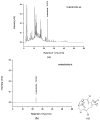Antioxidative characteristics of Anisomeles indica extract and inhibitory effect of ovatodiolide on melanogenesis
- PMID: 22754360
- PMCID: PMC3382824
- DOI: 10.3390/ijms13056220
Antioxidative characteristics of Anisomeles indica extract and inhibitory effect of ovatodiolide on melanogenesis
Abstract
The purpose of the study was to investigate the antioxidant characteristics of Anisomeles indica methanol extract and the inhibitory effect of ovatodiolide on melanogenesis. In the study, the antioxidant capacities of A. indica methanol extract such as DPPH assay, ABTS radical scavenging assay, reducing capacity and metal ion chelating capacity as well as total phenolic content of the extract were investigated. In addition, the inhibitory effects of ovatodiolide on mushroom tyrosinase, B16F10 intracellular tyrosinase and melanin content were determined spectrophotometrically. Our results revealed that the antioxidant capacities of A. indica methanol extract increased in a dose-dependent pattern. The purified ovatodiolide inhibited mushroom tyrosinase activity (IC(50) = 0.253 mM), the compound also effectively suppressed intracellular tyrosinase activity (IC(50) = 0.469 mM) and decreased the amount of melanin (IC(50) = 0.435 mM) in a dose-dependent manner in B16F10 cells. Our results concluded that A. indica methanol extract displays antioxidant capacities and ovatodiolide purified from the extract inhibited melanogenesis in B16F10 cells. Hence, A. indica methanol extract and ovatodiolide could be applied as a type of dermatological whitening agent in skin care products.
Keywords: Anisomeles indica; antioxidant; melanin; melanogenesis; ovatodiolide; tyrosinase.
Figures










Similar articles
-
Inhibition of melanogenesis and antioxidant properties of Magnolia grandiflora L. flower extract.BMC Complement Altern Med. 2012 Jun 6;12:72. doi: 10.1186/1472-6882-12-72. BMC Complement Altern Med. 2012. PMID: 22672352 Free PMC article.
-
Inhibitory effects of adlay extract on melanin production and cellular oxygen stress in B16F10 melanoma cells.Int J Mol Sci. 2014 Sep 19;15(9):16665-79. doi: 10.3390/ijms150916665. Int J Mol Sci. 2014. PMID: 25244016 Free PMC article.
-
Antioxidative properties and inhibitory effect of Bifidobacterium adolescentis on melanogenesis.World J Microbiol Biotechnol. 2012 Sep;28(9):2903-12. doi: 10.1007/s11274-012-1096-0. Epub 2012 Jun 14. World J Microbiol Biotechnol. 2012. PMID: 22806726
-
Ethyl acetate extract from Panax ginseng C.A. Meyer and its main constituents inhibit α-melanocyte-stimulating hormone-induced melanogenesis by suppressing oxidative stress in B16 mouse melanoma cells.J Ethnopharmacol. 2017 Aug 17;208:149-156. doi: 10.1016/j.jep.2017.07.004. Epub 2017 Jul 8. J Ethnopharmacol. 2017. PMID: 28689798
-
Evaluation of the effect of Thai breadfruit's heartwood extract on melanogenesis-inhibitory and antioxidation activities.J Cosmet Sci. 2008 Jan-Feb;59(1):41-58. J Cosmet Sci. 2008. PMID: 18350234
Cited by
-
Ovatodiolide suppresses colon tumorigenesis and prevents polarization of M2 tumor-associated macrophages through YAP oncogenic pathways.J Hematol Oncol. 2017 Feb 28;10(1):60. doi: 10.1186/s13045-017-0421-3. J Hematol Oncol. 2017. PMID: 28241877 Free PMC article.
-
Ovatodiolide of Anisomeles indica Exerts the Anticancer Potential on Pancreatic Cancer Cell Lines through STAT3 and NF-κB Regulation.Evid Based Complement Alternat Med. 2016;2016:8680372. doi: 10.1155/2016/8680372. Epub 2016 May 8. Evid Based Complement Alternat Med. 2016. PMID: 27242913 Free PMC article.
-
Genotoxicity and 28-day repeated dose oral toxicity study of ovatodiolide in rats.Toxicol Rep. 2021 Oct 11;8:1783-1791. doi: 10.1016/j.toxrep.2021.10.010. eCollection 2021. Toxicol Rep. 2021. PMID: 34722163 Free PMC article.
-
Ovatodiolide targets chronic myeloid leukemia stem cells by epigenetically upregulating hsa-miR-155, suppressing the BCR-ABL fusion gene and dysregulating the PI3K/AKT/mTOR pathway.Oncotarget. 2017 Dec 14;9(3):3267-3277. doi: 10.18632/oncotarget.23231. eCollection 2018 Jan 9. Oncotarget. 2017. PMID: 29423045 Free PMC article.
-
Antinociceptive and Anxiolytic and Sedative Effects of Methanol Extract of Anisomeles indica: An Experimental Assessment in Mice and Computer Aided Models.Front Pharmacol. 2018 Apr 12;9:246. doi: 10.3389/fphar.2018.00246. eCollection 2018. Front Pharmacol. 2018. PMID: 29706888 Free PMC article.
References
-
- Bergendi L., Benes L., Durackova Z., Ferencik M. Chemistry, physiology and pathology of free radicals. Life Sci. 1999;65:1865–1874. - PubMed
-
- Darr D., Fridovich I. Free radicals in cutaneous biology. J. Invest. Dermatol. 1994;102:671–675. - PubMed
-
- Sies H., Stahl W. Nutritional protection against skin damage from sunlight. Annu. Rev. Nutr. 2004;24:173–200. - PubMed
-
- Slominski A., Tobin D.J., Shibahara S., Wortsman J. Melanin pigmentation in mammalian skin and its hormonal regulation. Physiol. Rev. 2004;84:1155–1228. - PubMed
Publication types
MeSH terms
Substances
LinkOut - more resources
Full Text Sources
Other Literature Sources
Medical

